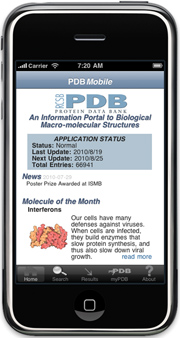DATA
QUERY, REPORTING AND ACCESS
Latest Website Release

To install PDBMobile on your iPhone or iPod (with at least iOS 4.1), point its web browser to www.pdb.org.
New and enhanced features were added to www.pdb.org at the beginning of October, including:
• Improved navigation of Molecule of the Month archive: new category views and a new sortable table to view features by category, date and name.
• PDBMobile for the iPhone: search the RCSB PDB, browse results, access MyPDB, and read the latest news and Molecule of the Month features.
PDBMobile is an HTML5-based application for mobile devices. It initially targets iPhone and iPod devices running iOS4. Future releases will target other platforms, including the iPad, Google Android and Windows Phone 7.
• New ways to explore search results using data distribution summaries. Search results now offer summary charts for standard characteristics of PDB entries (resolution, release date, experimental method, polymer type, organism, taxonomy) that can be used to refine search results into subsets of interest. For example, users can use these drill-down options, or 'faceted search' options, to quickly access high resolution entries from a structure type search; human-related entries from a sequence search; or most recent entries resulting from a chemical component search. Any combination of categories is possible.
• Integration with Binding Affinity Data from BindingDB (www.bindingdb.org). The Ligand Chemical Component widget on a Structure Summary page lists and links to binding affinity data from BindingDB (when available).
• New Help features, including a sitemap and glossary.
For complete descriptions, see the New Features widget on the RCSB PDB home page.
 Data distribution summaries can be used to explore the latest weekly update of PDB entries or the entire PDB archive by clicking on the links in the top menu bar (In this example, it read As of Tuesday Sep 21, 2010 at 5 PM PDT there are 68139 Structures). Data distribution summaries can be used to explore the latest weekly update of PDB entries or the entire PDB archive by clicking on the links in the top menu bar (In this example, it read As of Tuesday Sep 21, 2010 at 5 PM PDT there are 68139 Structures).
 Each chart can be used to drill down further, or to explore the entries in a given data distribution. Each chart can be used to drill down further, or to explore the entries in a given data distribution.
Analyze Small Molecule Interactions in the PDB with Ligand Explorer
Ligand Explorer can display hydrogen bonds, hydrophobic interactions, bridged H-bonds, metal interactions, and neighbor residue interactions and thresholds in a dynamic viewer.
Users can toggle interactions on/off, adjust distance thresholds, label interactions by distance, and display all neighbor residues. Distances, angles, and dihedral angles can be analyzed and measured. The views created can be saved as an image file, or as a text file listing interactions.
Ligand Explorer can be accessed from the Ligand Chemical Component section of an entry's Structure Summary page. The
program uses the same Molecular Biology Toolkit1 as the RCSB PDB's Protein Workshop and Simple Viewer.
Launching Ligand Explorer can install a local copy of the program on your computer, and can be used to read a local PDB file, or access a PDB file directly using the File menu (when online).

Ligand Explorer dynamically displays the interactions in PDB entry 2w70
dConsensus
A paper describing dConsensus has been published:
dConsensus: a tool for displaying domain assignments by multiple structure-based algorithms and for construction of a consensus assignment Kieran Alden, Stella Veretnik, Philip E Bourne (2010) BMC Bioinformatics 11:310. doi:10.1186/1471-2105-11-310
Website Statistics
Website access statistics for the second quarter of 2010 are given below.
Month |
Unique Visitors |
Visits |
Bandwidth |
July '10 |
154256 |
395745 |
767.18 GB |
August '10 |
159350 |
396199 |
783.32 GB |
September '10 |
210919 |
477825 |
1344.88 GB |
The Molecular Biology Toolkit (MBT): A Modular Platform for Developing Molecular Visualization Applications (2005) BMC Bioinformatics, 6: 21. |



 Each chart can be used to drill down further, or to explore the entries in a given data distribution.
Each chart can be used to drill down further, or to explore the entries in a given data distribution.
